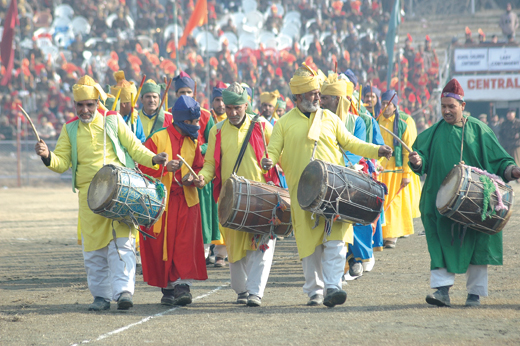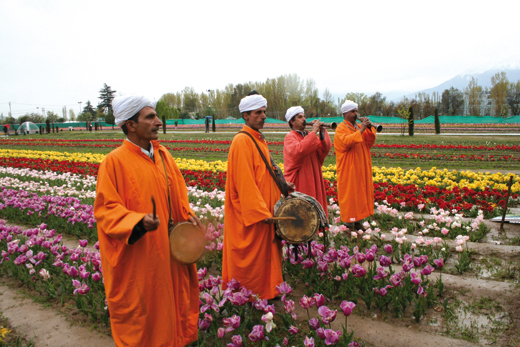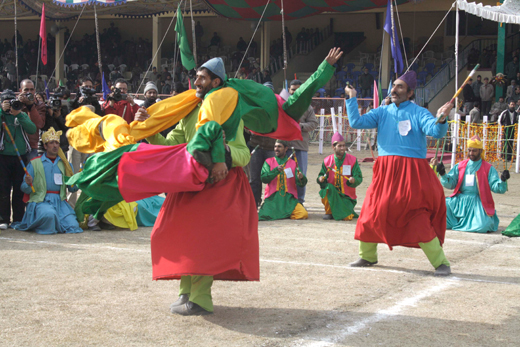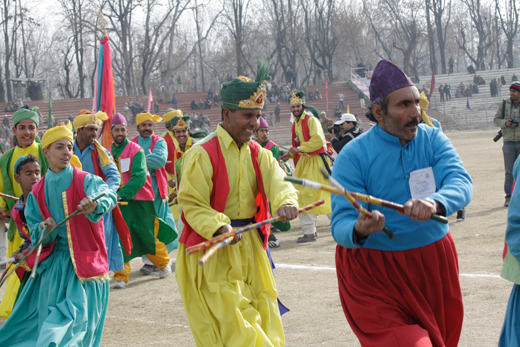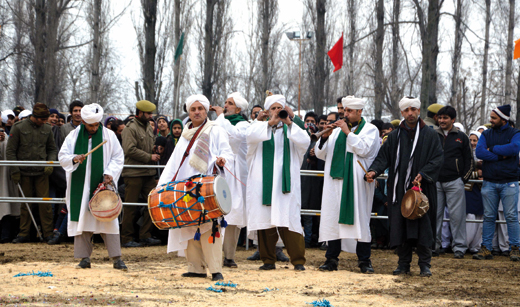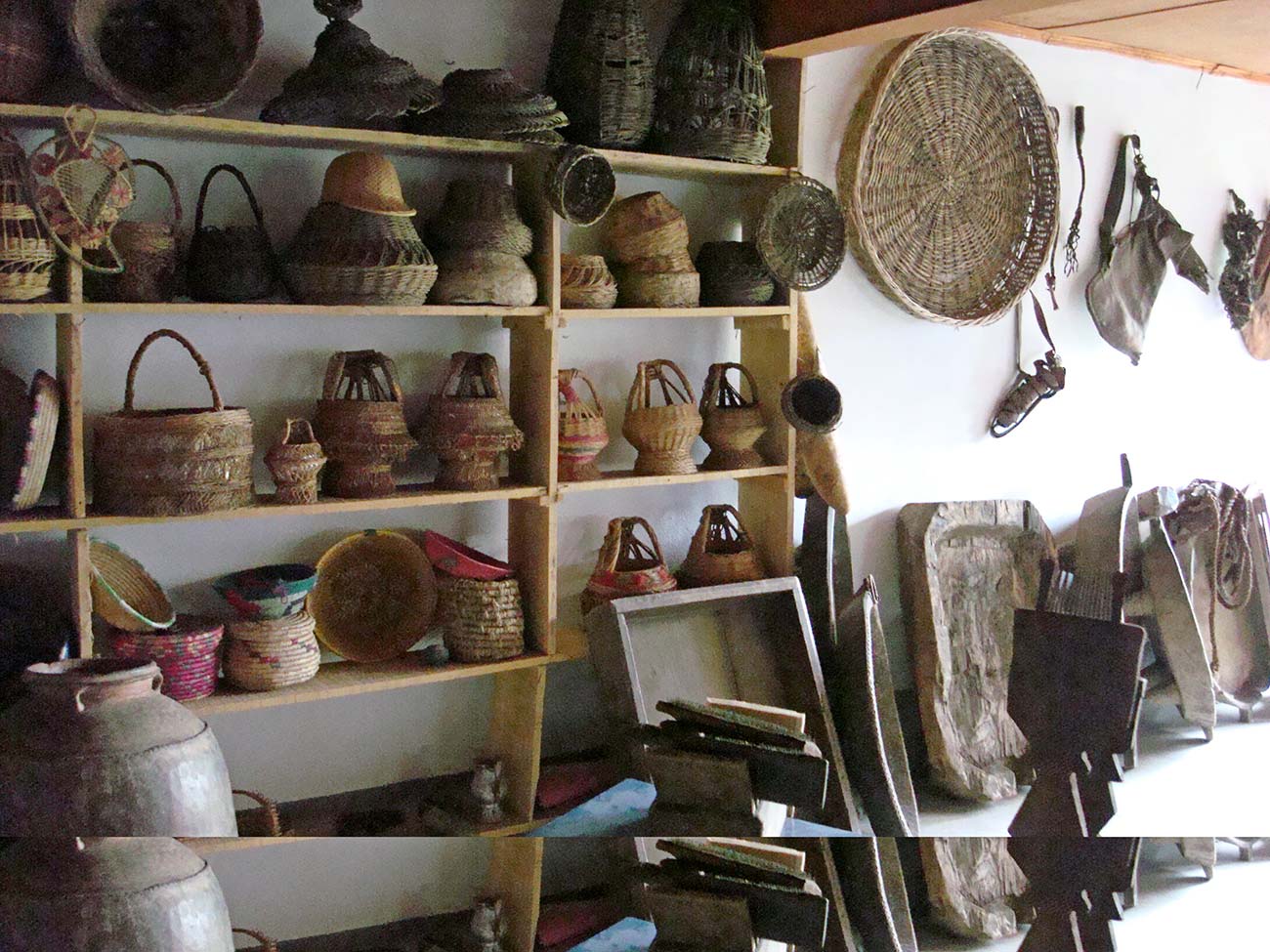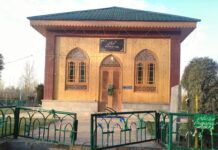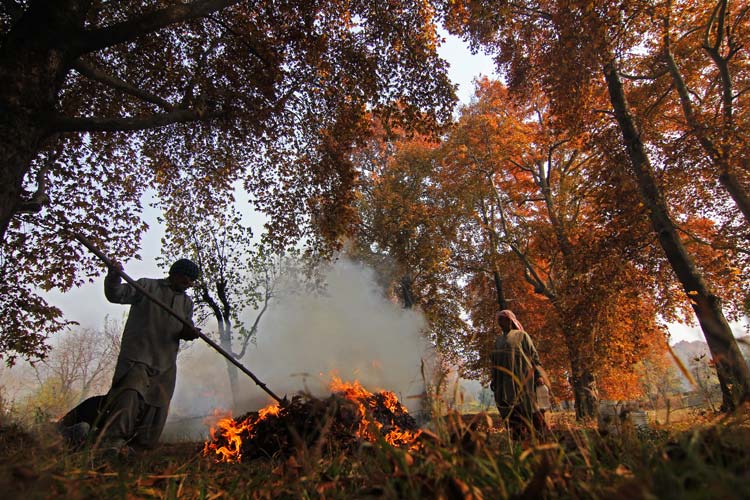The down spiral of Kashmir’s centuries old folk art Bhaand-e-Paether is often attributed to the turmoil in Kashmir; however, the ‘other’ factors pounding it down have conveniently been ignored along the way. Suhail A Shah discovers many interesting factors that is changing, or has changed the destiny of people who knew what Bhaand-e-Pather is all about
He does not remember the exact year. But 76 year old Bhaand-e-Paether artist Ghulam Rasool Bhagat vividly remembers performing before then Chief Minister of Jammu and Kashmir, Ghulam Muhammad Sadiq.
Another thing that remains clearly etched into his memory are Sadiq’s words, “Had it been any other Chief Minister in my place, you would definitely have landed in jail.”
“Woven in satire, our performance then was laced with criticism of the ruling class,” recalls Rasool, a tall lean man, his panting for breath not a deterrent while he enthusiastically unravels his journey as a Bhaand. Rasool is the elder brother of the legendary Paether artist, Mohammad Subhan Bhagat.
Since then Rasool and his other contemporaries have seen the art, Bhaand-e-Paether, take a downslide owing to a multitude of factors, including a three year gag during Syed Mir Qasim’s tenure as the Chief Minister of Kashmir.
Off late the armed rebellion against Indian rule in Kashmir has often been held responsible for the decline of this art, with some people alleging that the militants in fray to implement a puritan form of Islam in Kashmir did not allow the Bhaands to perform, for it’s not permissible in Islam. The social observers and people well acquainted with the ‘art and culture’ of Kashmir however opine differently, arguing that there is more to the subject than what meets the eyes.
Does not matter what the odds be, the artists associated with the Paether are now clawing back with whatever little resources at their disposal and the ship has been steadied to some extent.
The centuries old, Kashmir’s indigenous folk art, Bhaand-e-Paether, has been the only source of entertainment and/or information for Kashmiri people. Based on a central theme, usually satire, the ‘Paether’ has been vital in getting to fore the social issues plaguing the society.
Besides, the most important contribution of the art has been the criticism of the people at helm of affairs, which sadly has been missing during the ‘renaissance’ period of the art. Onus lies on the almost complete dependence of the artists on state run mechanisms of revival.
A brief history:
Though there is no concrete evidence of the fact but oral history suggests that this art form has been prevalent in Kashmir for more than 1500 years now.
Noted poet, historian and social activist of Kashmir, Zareef Ahmad Zareef links the art to the era, when Kashmir was predominantly a Hindu society with Hindu rulers.
“The Bhaands essentially used to be entertainers, of the rulers as well as the common people,” Zareef says, “They enthralled their audiences with music and drama and received gifts mostly in kind,”
Their performances however remained limited to time of festivities among the common folk and attending the rulers on call.
The historians maintain that there was a structural rehash in the way these folk artists functioned, centuries later, precisely at the time when Mughals were ruling most parts of the Indian sub-continent, including Kashmir.
Written history suggests that poverty was widespread during the Mughal era. Moreover some of the people appointed to run affairs for Mughals in Kashmir have been best described as tyrants by the historians.
It was during this time, the artists and the historians believe that the Bhaands of that period successfully conceived the ideas of different acts or Paethers which include the legendary Raaz-e-Paether, Buhir-Paether, and Dard-e-Paether.
The focus shifted from only entertaining to educate people about their rights and the wrongdoings of the rulers as well. They were invited to the court, where they criticised the official misdeeds, using satire as an effective tool.
The Bhaands kept improving a notch with every invader that ruled Kashmir. They delivered their dialogues in Persian when they performed before the Mughals and kept improvising as the rulers changed.
“Like while the Afghans ruled Kashmir the intelligent Bhaands included another act to their kitty, called the Bachche Nagme,” says Zareef.
Zareef adds that the Bachche Nagme, in which a male child dancer was dressed up like a girl, was added to keep the interest of Afghan rulers afloat in the folk culture of Kashmir.
The Sikh regime followed the Afghans and it was a lean period for the Bhaands given that the Sikhs remained interested only in accumulation of wealth, according to Zareef “They remained aloof from art,”
Howsoever tyrannical the Dogra regime was for the common Kashmiri, the Bhaand-e-Paether thrived during that period.
“The Dogras even spared our forefathers from Begaer (forced labour),” says Rasool, “That was the golden era for Bhaands,”
Rasool says that that was the time when people from the farming community married their daughters to Bhaands gleefully, for it meant that their whole family got exempted from the forced labour.
“It was unlike the days that were to follow. Bhaands were a special lot,” says Rasool, “There was no stigma attached to what we did and financially we were better off than we could ever be after that.”
As people worked in the fields, under the strict vigil of Maharaja’s men, Bhaands brought a little cheer in the hardest of the days. People working in these fields (called Khal locally, which also means a small village market) they were ordered to pay the Bhaands a part of their crop, as and when it was ready.
Partition happened and a subsequent Indian rule in Kashmir followed. Soon the people started to look down upon the Bhaands. Bhaand-e-Paether started to be associated with beggary.
The reasons were multiple. The official patronage was no longer there, which left the Bhaands utterly dependent upon the local populace and whatever little they were offered in kind while performing in one village or another. Radio, Television and other modern gadgetry came into place and replaced Paether as a source of entertainment, at least to some extent. Besides, people were at least visibly free from the forced labour. And this was the beginning of the downslide of the art.
The ‘Gun’ and the ‘Paether’:
Ghulam Muhammad Bhagat is 58 years old. A clean shaven stout man, Ghulam claims to have been associated with the Bhaand-e-Paether ever since he stopped getting breast fed by his mother. His father used to take him along and the next logical step was to perform. He was just finding a foot hold in the art, discovering his strengths and weaknesses when things changed in Kashmir.
An armed rebellion against Indian rule in Kashmir erupted and despite the encounters and the bombings, life for Ghulam came to a grinding halt.
“I held my album, looked at the pictures and cried like a baby,” Ghulam says, “I wanted to sing, I wanted to perform but….”
He however realizes that the time was inappropriate for him to sing or perform for that matter.
“Every village, every household in Kashmir was in mourning. I soon realized that there were no happy people left in the beautiful vale,” says Ghulam, adding that anybody performing at that point of time would have got to be insensitive to the core.
A senior journalist puts it like this, “When a house is in mourning even the kids playing are asked to shut up and sit down.”
Even though they might have to agree to some ‘propaganda’ publicly, in private Bhaands do acknowledge the fact that, barring some stray incidents, the militants did not harass them.
In fact a Bhaand, requesting not to be named for this, had an interesting story to share.
“During later part of the turbulent 90’s we were performing at a village and a kid came and requested me to change the venue,” says the Bhaand, “When I enquired further I was told that some militants were in hiding inside a house and wanted to watch the Paether. We did change the venue.”
Zareef maintains that the art form was bound to get a pounding during the turmoil. “There were times when business men of Kashmir had nothing to feed their families, during the 90’s.”
Everything was hit very hard and Bhaand-e-Paether would have been no exception, adds Zareef. Moreover, Zareef feels that the downfall of the art had begun much before the militancy erupted in Kashmir.
He says that the ‘gag’ during the regime of Qasim is debatable, for it might have been also because he was just a care taker, with no funds to spend on art, till Shiekh Muhammad Abdullah was handed over the reins.
“Shiekh however disapproved Bhaand-e-Paether for religious reasons and he made no secret about it,” said Zareef, “So the point I want to make is that the problems for Bhaands just multiplied during the militancy.”
Besides, any form of art is bound to suffer within a conflict zone, says Imtiyaz Sheikh, who teaches history to Civil Services aspirants, “I don’t see a reason why Bhaand-e-Paether would have survived.”
There were instances however that frightened the artists in Kashmir, like the killing of a Radio Kashmir employee, Shameema, who was found dead on the banks of river Jhelum on a June morning in 1993. Suspected to be killed by militants for ‘collaborating’ with Indian agencies, Shameema became a reason for many Bhaands to quit the art and take menial jobs for living.
As the graph of armed struggle was on a down ward spiral in late nineties, the artists associated with this indigenous art started to regroup, with official patronage of course. Programmes were arranged in the Mughal gardens of Srinagar for Bhaands to portray a picture of normalcy in Kashmir.
Importantly, it was during the time of the strife in the Valley that the younger generation of Bhaands got disgruntled with the art, for the financial aspect of their lives forced the youngsters as well to take other professions.
Moreover they got to perform at government functions including Indian Republic and Independence Day Parades. Unfortunately this time around the government intervention, seeds of which had been sown soon after Kashmir’s contentious accession to India, began to play its part.
“The art of Bhaand-e-Paether no longer reflects common man’s pain, aspiration and dreams,” says Arshad Mushtaq, Kashmir’s renowned theatre personality.
‘Indianising’ the ‘Secular’ Paether:
It was during the time they performed before Sadiq, says Rasool, that the then Secretary of the Kashmir’s Academy of Art, Culture and Languages Moti Lal Kemmu roped the Bhaand’s with the Academy.
“We got a stipend of 100 Rupees per month and a target of 15 programmes in a year,” says Rasool, “The money was huge at that point of time but it continued to remain more or less the same, before it was stopped some two years back.”
The roping in of these artists with the Cultural Academy, maintains Zareef, was the beginning of the ‘Indianization’ of Bhaand-e-Paether, “It was indeed difficult for these artists to keep intact the essence of their art, which was of course criticism of the tyrant, intact while living solely on government funding.”
Arshad Mushtaq is of the opinion that the Cultural Academy was created to kill the indigenous art and the artists of Kashmir, Bhaands being the most glaring of the examples.
“They were loved in the local circles for bringing to fore the sufferings of people,” says Arshad, “But they no longer can do that, for they have been made dependent on the government instead of the common people, who gave them a share of their crop as a token of their love.”
Arshad however maintains that the seeds of the ‘Indianizing’ the art were sown much before Moti Lal Kemmu roped in the Bhaands with the Academy.
The ‘Nehruvian’ India and ‘Nehruvian vision to Kashmir’ changed it all, says Arshad, “In 1952 Pran Kishore was asked to do the play ‘Boumber te Yemberzal’ and Dina Nath Nadim was asked to write it, for an audience of Russian diplomats.”
The very next day they [Russians] offered support to Indian stand on Kashmir, laments Arshad.
Sheikh adds that even if we remain very sceptical and cynical about the whole ‘Indianizing’ thing, still this kind of folk art is being used as a source to take attention away from some pressing issues which otherwise should bother people.
Another major reason of the down spiral, some artists believe, has been the secular nature of this particular art.
“If you see other theatre artists across India, they flourish because almost each one of them represents a particular religion like the Ramlila Mandali and others,” says 55 year old Gul Muhammad Bhagat, Subhan Bhagat’s son, “Our secular approach has somehow been our downfall. Today people before watching us perform ask, isn’t this prohibited in the religion?”
The ‘Revival’ of sorts:
The official apathy, from State government, towards the art is a stark reality. That has been the major reason, if not the only one, for the newer generation of Bhaands to explore other options.
“If you see folk artists world over, they are thriving,” says an Indian theatre personality of Kashmiri origin, M K Raina, who has played a major part in revival of the art in Kashmir.
It was Raina who travelled extensively in Kashmir, after almost a decade in exile, and convinced the Bhaands from different places to work for him.
“I got a project, to train young local boys, approved from the National School of Drama (NSD),” said Raina, a NSD graduate, “It came off well and the response from the boys selected was over whelming.”
It was during that workshop, which was held in Akingam village of South Kashmir’s Islamabad district that Raina convinced the artists to perform in a Kashmiri adaptation of Shakespearean tragedy King Lear.
The act was performed, in 2011, by the local artists at the Kashmir Bhagat Theatre in Akingam before an overwhelmingly large crowd. After that there has been a renewed interest among the younger generations of the Bhaand household.
After the King Lear performance many Kashmiri Bhaand Troupes have been extensively travelling and performing in many Indian cities. Many have been conferred upon with different wards as well. Rasool, in 2012, was conferred upon a Sangeet Natak Academy Award.
Besides, many of them have been getting offers to perform in some European countries as well.
23 year old Manzoor-ul-Islam Bhagat got trained at the work shop, by NSD, and since then has been elevated to a Magun in his group.
Manzoor thinks that the future, despite the official apathy, seems to be bright for the Bhaands.


